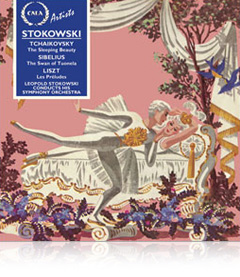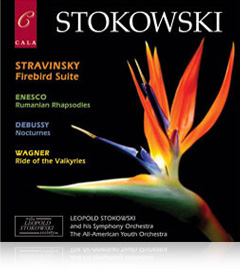| March 1, 2009
 Cala Records Preserves Gems
of Stokowski's Remarkable Discography Cala Records Preserves Gems
of Stokowski's Remarkable Discography
This year brings us several noteworthy centenaries and
bicentenaries: 1809 saw the birth of Felix Mendelssohn and Abraham Lincoln, just nine days
apart, and the death of Joseph Haydn; 1909 was the year Gustav Mahler became conductor of
the New York Philharmonic, the year Stravinsky received Diaghilev’s commission for
the work that would make him famous literally overnight -- The Firebird -- and
the year Leopold Stokowski began his phenomenal podium career in America, with the
Cincinnati Symphony Orchestra, at age 27. Stokowski, perhaps the most fascinating of the
numerous outstanding conductors of the last century, had come from England to be the
organist at St Bartholomew’s Church in New York before taking that post in Cincinnati
-- which he left three years later to begin making history with the Philadelphia
Orchestra.
Apart from the premieres of important works, apart from his
wizardry in eliciting from the Philadelphia musicians a richness, sweetness and brilliance
rarely combined in a single orchestral body, and more rarely still on the heady level to
which Stokowski took his troops, a prime factor in the history he made was his being the
first major musician to recognize the importance of recordings, in both bringing music to
an infinitely larger audience than any orchestra had enjoyed and in so doing earning
himself and his orchestra a worldwide reputation such as few had ever imagined.
Stokowski made his first recording (first for the
Philadelphia Orchestra as well, Brahms’s Hungarian Dances Nos. 5 and 6) in 1917; once
he got started, he never stopped, but eagerly welcomed each new technical refinement in
building his remarkable discography. After founding the American Symphony Orchestra in New
York and seeing it through its first ten years he settled in the village of Nether Wallop
in his native country and committed himself to a busy schedule of recording in London. His
last sessions took place there just before his death at age 95 (with five years left to
run on his contract with Columbia Records!). For 23 of those 60 years he recorded with the
Philadelphia Orchestra, and after that with ten orchestras in New York (three of
which he created, one of which was assembled to record with him), the big London
orchestras, still others in Chicago, Los Angeles, San Francisco, Houston, Prague, Paris,
Moscow, Berlin, Geneva, Hilversum, even Philadelphia again (as guest, in 1960), for more
than a dozen labels.
If recordings played an important part in putting Stokowski
and the Philadelphians on the musical map, Stokowski and the orchestra played a no less
significant one in developing the art and science of sound recording. They recorded
full-length symphonies and concertos for Victor during the pre-electrical years; once the
electrical process was introduced, in 1925, most of the earlier recordings were remade as
new titles were added, and Stokowski’s Philadelphia Orchestra became the living
laboratory for RCA Victor. When the Great Depression brought about a cessation of most
orchestral recording in America -- even Toscanini’s New York Philharmonic and
Koussevitzky’s Boston SO were dropped for years -- the Philadelphians continued
without let-up, and in fact added to their regular activity in the Victor studios live
concert takes in their own hall and early experiments in stereophonic sound and
long-playing discs.
Stokowski saw possibilities in the "electronic
media" beyond the imagination of most of his colleagues. He took such an interest in
the technical aspects of recording that he not only devised (or agreed to) special seating
for his musicians but sometimes took to fiddling with the recording equipment between
takes. One producer had a dummy control panel made for him, to keep him occupied -- and
keep him away from the real one. He appeared in movies -- not only conventional ones built
around musicians but in the Disney classic Fantasia, whose 16-channel
soundtrack (and seeing the legendary conductor shake hands with Mickey Mouse) got a
generation of amazed youngsters hooked on symphonic music.
In 1947, when Stokowski was recording for RCA Victor with
"His Symphony Orchestra" (among whose members were several first chairs of the
New York Philharmonic), he recorded a generous collection of excerpts from
Tchaikovsky’s ballet The Sleeping Beauty. The promotional material for that
set of 78s (and, if memory serves, the documentation in the album itself) included a
photograph of a recording session, made in a huge space, with the various orchestral
choirs spread out in corners of their own, each with its own microphones. The result was
extraordinarily spacious and vivid. In praising an unrelated subsequent recording, Irving
Kolodin, then the preeminent critic reviewing recorded music, praised it as having "Sleeping
Beauty sound." Naturally, when such developments as the LP, stereo, and quad came
along, Stokowski didn’t have to be asked twice to remake his favorite pieces and find
some new ones to add to the discography which for years certified him as the most heavily
recorded conductor of his time.
By now almost all of Stokowski’s recordings have been
recirculated on CD, either by the respective originating labels (RCA Victor,
Columbia/Sony, Decca, Capitol/EMI, Vanguard, Everest) or on "historical"
specialist labels (Music & Arts, Biddulph, Pearl, Guild), and since his death there
have also been several recordings of his famous transcriptions. The most recent -- and by
all odds the most successful -- of these are the Naxos CDs Stokowski’s onetime
protégé José Serebrier has made with the Bournemouth SO: two discs of Bach
arrangements, one of Mussorgsky, and one of Wagner. This project was initiated and in
large part funded by the London-based Leopold Stokowski Society, which has also given us
the most wide-ranging series of Stokowski reissues yet, drawing on many sources for
excellent restorations and methodically adding to a catalogue likely to have a greater
permanency than any similar undertaking, with a schedule of "at least two issues per
year" and no deletions.
This is of course the remarkable Stokowski series on Cala
Records, overseen by the chief keeper of the Stokowski flame, Edward Johnson, who has
tirelessly and effectively undertaken this challenge to ensure that very few Stokowski
recordings shall be left behind. Over the years Mr. Johnson, who serves as project manager
for the Stokowski Society and editor of its journal Toccata, has persuaded several
conductors to perform and record the Stokowski transcriptions. One of these was Matthias
Bamert, who recorded them for Chandos several years before Mr. Serebrier got to them for
Naxos. Another was Geoffrey Simon, who also recorded for Chandos before founding his own
label, Cala, in part to record transcriptions by the likes of Stokowski and Percy
Grainger, which have always been of special interest to him. Mr. Johnson was involved in
devising some of the repertory for Mr. Simon’s recordings, and he received an
enthusiastic response when he suggested the collaboration between Cala and the Stokowski
Society, which has so far given us 33 certifiably valuable issues.
While the reissue specialist labels generally work from
mint-condition 78s and LPs -- and, to be sure, some of the excellent transfers for the
Cala series were made this way -- for the most part the originating companies were
directly involved here, and in licensing their material provided not only the original
master tapes (or metal parts for 78s) but in some instances the original cover art as
well.
The Society went after and obtained some of
Stokowski’s very latest recordings, in splendid stereophonic sound, as well as older
material, and brought some of them to CD for the first time. Among these are Elgar’s Enigma
Variations with the Czech Philharmonic, the Brahms First and Messiaen L’Ascension
with the LSO, and the Franck Symphony with the Hilversum Radio Philharmonic, all from
Decca, and several of the very latest Columbia/Sony items with the National Philharmonic
(a fine orchestra of top-tier London musicians, formed especially for recording): Aurora’s
Wedding, Brahms’s Second Symphony, a splendid bundle of transcriptions.
 In other cases, when the
companies have deleted some of their own CD reissues, such as the marvelous 1964 Scheherazade
with the LSO and the Vivaldi and Handel titles on Decca, and Mendelssohn’s
"Italian" Symphony on Columbia/Sony, the Stokowski Society has been quick to
obtain them for its series -- and such items are freshly remastered. In other cases, when the
companies have deleted some of their own CD reissues, such as the marvelous 1964 Scheherazade
with the LSO and the Vivaldi and Handel titles on Decca, and Mendelssohn’s
"Italian" Symphony on Columbia/Sony, the Stokowski Society has been quick to
obtain them for its series -- and such items are freshly remastered.
Previously issued commercial recordings do not make up the
entirety of this series -- there are also Philadelphia recordings which RCA Victor had
never issued in any format, and there is material from Stokowski’s broadcasts with
the NBC SO in the early 1940s -- but they do constitute the greater part of its titles,
and for most collectors they are the meatiest parts of it. The famous 1947 Sleeping
Beauty is on CACD 0522, with two other "His SO" gems from the same year,
Sibelius’s Swan of Tuonela (with Mitchell Miller, English horn) and the Liszt
tone poem Les Préludes. A different assortment from The Sleeping Beauty -- the
aforementioned Aurora’s Wedding (Diaghilev’s downsizing of the
full-evening ballet to a single act) -- in opulent 1975 stereo, is on CACD 5029, together
with the collection of Stokowski transcriptions also mentioned above.
An earlier recording of Aurora’s Wedding, with
His SO on a monophonic RCA LP, may turn up later; meanwhile, from the same His SO period,
we have Stokowski’s only recordings of Schumann and Haydn Symphonies (Nos. 2 and 53,
respectively) on CACD 0532, with short pieces by Humperdinck, Mozart and Johann Strauss.
The Haydn, known as "The Imperial," is in the Fendler edition, with the
"wrong" finale, but it is a stunning performance.
The December 1940 account of Mozart’s Sinfonia
concertante for wind quartet, with the Philadelphia first chairs as soloists,
Stokowski’s last recording with the Philadelphians until his return as guest
conductor 20 years later, remains his only recording of a large-scale Mozart work. It was
also the only recording of this work in general circulation here until after World War II.
The coupling on CACD 0523 is Beethoven’s Pastoral Symphony, with the short-lived New
York City SO.
 The later of last
year’s two issues brings together, under the fully justified heading "The
Eternal Magician," three of Stokowski’s most admired His SO items from the early
1950s -- Stravinsky’s Firebird Suite (the sixth of his eight recordings
of it), Enescu’s Romanian Rhapsodies Nos. 1 and 2, and Debussy’s Three
Nocturnes -- with a heretofore unreleased, and amazingly vivid, Columbia
"binaural" recording of the Ride of the Valkyries with the All-American
Youth Orchestra. The later of last
year’s two issues brings together, under the fully justified heading "The
Eternal Magician," three of Stokowski’s most admired His SO items from the early
1950s -- Stravinsky’s Firebird Suite (the sixth of his eight recordings
of it), Enescu’s Romanian Rhapsodies Nos. 1 and 2, and Debussy’s Three
Nocturnes -- with a heretofore unreleased, and amazingly vivid, Columbia
"binaural" recording of the Ride of the Valkyries with the All-American
Youth Orchestra.
Both the classic 1934 Philadelphia recording of the Nutcracker
Suite and the elegant postwar remake with His SO are on Cala, the former with a Scheherazade
of similar vintage on CACD 0521, the latter in a sumptuous "Heart of the Ballet"
collection on CACD 0547. The splendid stereophonic remake of the Rimsky title with the
LSO, from Decca’s Phase4 series, is on CACD 0536, not only remastered but with a
rehearsal segment as well as a rip-roaring live-concert Marche slave.
There are Bach transcriptions, of course, 11 of them, with
the All-American Youth Orchestra on CACD 0527, and there are substantial selections from
opera beyond concert excerpts: arias and choruses from Boris Godunov, with Nicola
Rossi-Lemeni, the San Francisco SO et al., coupled with His SO in Parsifal
orchestral excerpts (CACD 0535), and a still more generous helping of Saint-Saëns’s Samson
et Dalila, with Jan Peerce, Risë Stevens and Robert Merrill and the NBC SO, sharing
CACD 0540 with Licia Albanese in the Letter Scene from Evgeny Onegin, with His SO.
All of Stokowski’s Columbia recordings with the New
York Philharmonic are collected on three CDs (CACD 0533, 0534, 0537), and there is a 1958
Carnegie Hall concert with His SO, comprising works by Wallingford Riegger, Alan Hovhaness
and Paul Creston, plus the US premiere of Vaughan Williams’s Ninth Symphony (CACD
0539). The Victor recording of Percy Grainger pieces, for which Grainger made new
arrangements and took part as pianist with His SO, is revived on CACD 0542, together with
a rich assortment ranging from Vaughan Williams’s Tallis Fantasia to Ibert’s Escales.
The vigorous, surprisingly stylish accounts of Vivaldi’s Four Seasons (New
Philharmonia) and excerpts from Handel’s Messiah (LSO, chorus, soloists)
constitute a two-disc set (CACD 0538), and there are some intriguing novelties on the
first two CDs of early Philadelphia recordings (CACD 0501, 0502).
We might go on with more details, because there is no
hyperbole in stating that every one of these 33 items has a valid and delightful claim on
the attention of any and every listener, with consistently high sonic standards and with
detailed annotation by Edward Johnson or in some instances by Richard Gate -- but full
information is available on the websites of both Cala Records and the Leopold
Stokowski Society. In case you encounter a retailer unfamiliar with the Cala
label, the US importer is Albany Music Distributors.
. . . Richard Freed
richardf@ultraaudio.com
|